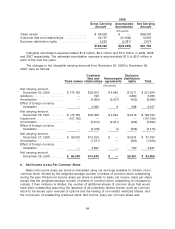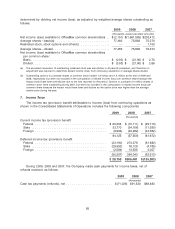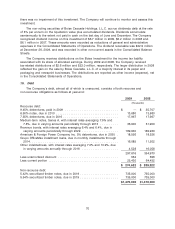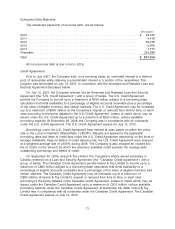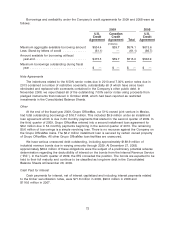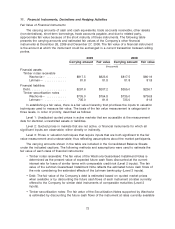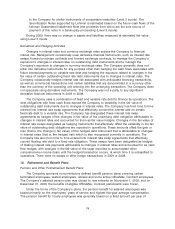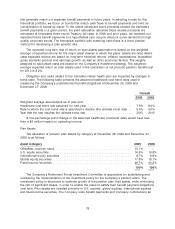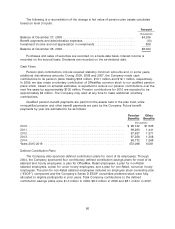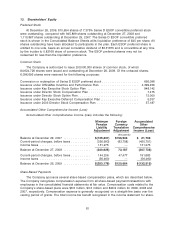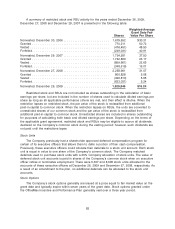OfficeMax 2009 Annual Report Download - page 78
Download and view the complete annual report
Please find page 78 of the 2009 OfficeMax annual report below. You can navigate through the pages in the report by either clicking on the pages listed below, or by using the keyword search tool below to find specific information within the annual report.to the Company for similar instruments of comparable maturities (Level 2 inputs). The
Securitization Notes supported by Lehman is estimated based on the future cash flows of the
Lehman Guaranteed Installment Note (the proceeds from which are the sole source of
payment of this note) in a bankruptcy proceeding (Level 3 inputs).
During 2009, there was no change in assets and liabilities measured at estimated fair value
using Level 3 inputs.
Derivatives and Hedging Activities
Changes in interest rates and currency exchange rates expose the Company to financial
market risk. Management occasionally uses derivative financial instruments, such as interest rate
swaps, forward purchase contracts and forward exchange contracts, to manage the Company’s
exposure to changes in interest rates on outstanding debt instruments and to manage the
Company’s exposure to changes in currency exchange rates. The Company generally does not
enter into derivative instruments for any purpose other than hedging the cash flows associated with
future interest payments on variable rate debt and hedging the exposure related to changes in the
fair value of certain outstanding fixed rate debt instruments due to changes in interest rates. The
Company occasionally hedges interest rate risk associated with anticipated financing transactions,
as well as commercial transactions and certain liabilities that are denominated in a currency other
than the currency of the operating unit entering into the underlying transaction. The Company does
not speculate using derivative instruments. The Company was not a party to any significant
derivative financial instruments in 2009 or 2008.
The Company uses a combination of fixed and variable rate debt to finance its operations. The
debt obligations with fixed cash flows expose the Company to variability in the fair value of
outstanding debt instruments due to changes in interest rates. The Company has from time to time
entered into interest rate swap agreements that effectively convert the interest rate on certain
fixed-rate debt to a variable rate. The Company has designated these interest rate swap
agreements as hedges of the changes in fair value of the underlying debt obligation attributable to
changes in interest rates and accounted for them as fair value hedges. Changes in the fair value of
interest rate swaps designated as hedging instruments that effectively offset the variability in the fair
value of outstanding debt obligations are reported in operations. These amounts offset the gain or
loss (that is, the change in fair value) of the hedged debt instrument that is attributable to changes
in interest rates (that is, the hedged risk) which is also recognized currently in operations. The
Company has also from time to time entered into interest rate swap agreements that effectively
convert floating rate debt to a fixed rate obligation. These swaps have been designated as hedges
of floating interest rate payments attributable to changes in interest rates and accounted for as cash
flow hedges, with changes in the fair value of the swap recorded to accumulated other
comprehensive income (loss) until the hedged transaction occurs, at which time it is reclassified to
operations. There were no swaps or other hedge transactions in 2009 or 2008.
12. Retirement and Benefit Plans
Pension and Other Postretirement Benefit Plans
The Company sponsors noncontributory defined benefit pension plans covering certain
terminated employees, vested employees, retirees and some active OfficeMax, Contract employees.
The Company’s salaried pension plan was closed to new entrants on November 1, 2003, and on
December 31, 2003, the benefits of eligible OfficeMax, Contract participants were frozen.
Under the terms of the Company’s plans, the pension benefit for salaried employees was
based primarily on the employees’ years of service and highest five-year average compensation.
The pension benefit for hourly employees was generally based on a fixed amount per year of
74


